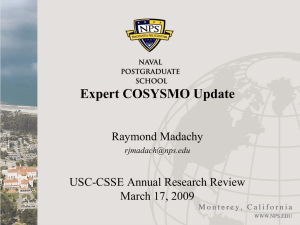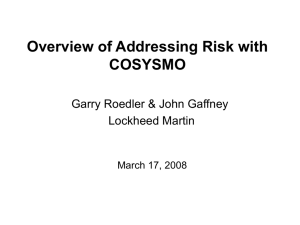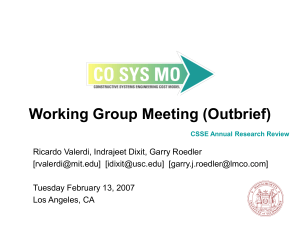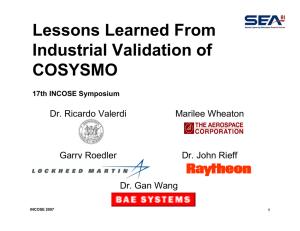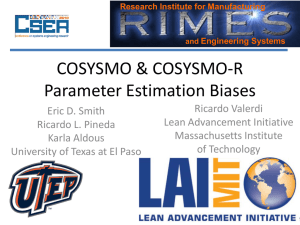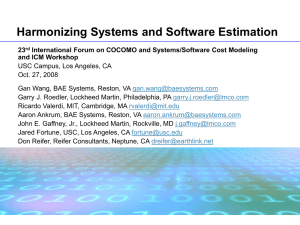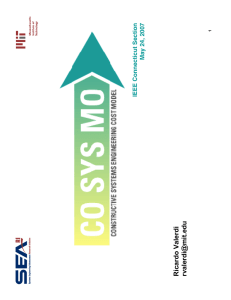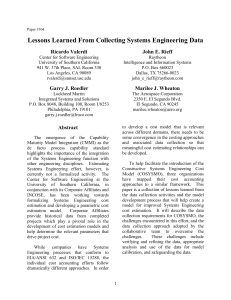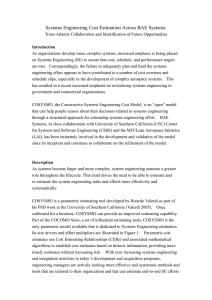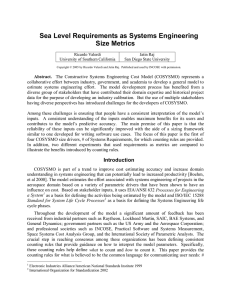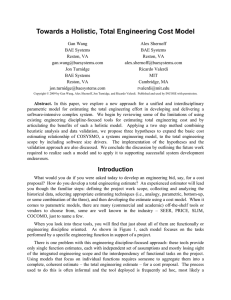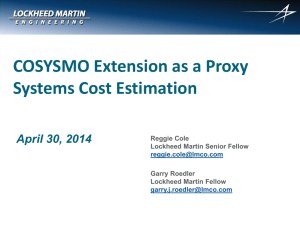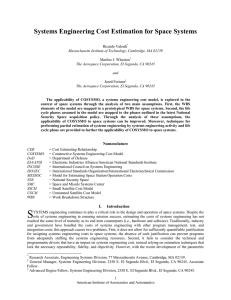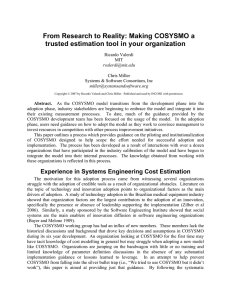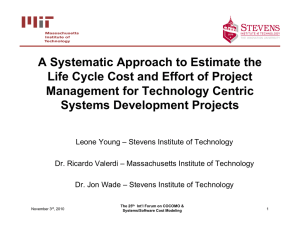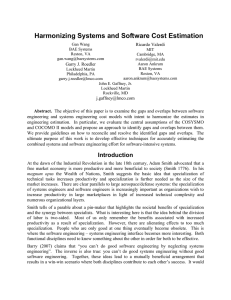Automating Systems Engineering Risk Assessment Ray Madachy, Ricardo Valerdi Naval Postgraduate School
advertisement
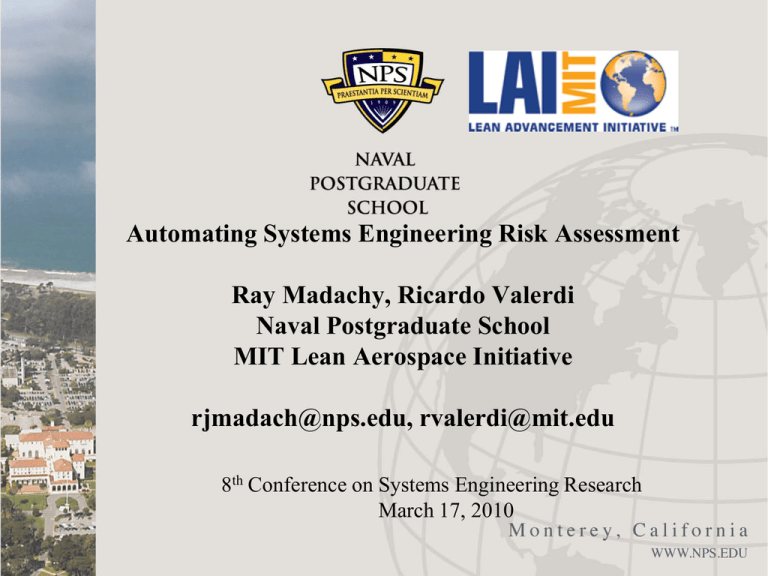
Automating Systems Engineering Risk Assessment
Ray Madachy, Ricardo Valerdi
Naval Postgraduate School
MIT Lean Aerospace Initiative
rjmadach@nps.edu, rvalerdi@mit.edu
8th Conference on Systems Engineering Research
March 17, 2010
Agenda
• Introduction and Overview
• Method
• Project Implementation
– Process and Measurement Frameworks
• Current and Future Work
2
Introduction
• The Constructive Systems Engineering Cost Model
(COSYSMO) is a parametric cost estimation model
for systems engineering effort [Valerdi 2005]
• Constructive: a user can tell why the model gives the
estimate it does, and helps the systems engineer
understand the job that needs to be done
• Expert COSYSMO leverages on the same cost factors
to identify, quantify and mitigate risks
• The dual nature of Expert COSYSMO extends the
constructiveness into risk management
3
Tool Overview
• An expert system tool for systems engineering risk management
based on COSYSMO
– Automatically identifies project risks in conjunction with cost estimation similar
to Expert COCOMO [Madachy 1997] and provides related advice
– Supports project planning by identifying, categorizing and quantifying systemlevel risks
– Supports project execution with automated risk mitigation advice for
management consideration
• Risk situations are characterized by combinations of cost driver
values indicating increased effort with a potential for more problems
• Simultaneously calculates cost and schedule to enable tradeoffs with
risk
https://diana.nps.edu/MSAcq/tools/ExpertCOSYSMO.php
or
http://csse.usc.edu/tools/ExpertCOSYSMO.php
4
Expert COSYSMO Operation
Integrated Estimation and Risk Analysis
Size
Drivers
User Input
Cost
Drivers
Cost
Estimating
Relationship
Rule-Based
Risk Heuristics
Cost Estimate with
Uncertainty Ranges
Risk Assessment
- Identification
- Analysis
- Prioritization
Risk Control
- Planning
- Monitoring
5
Knowledge Base
• Knowledge base elicitation from seasoned
domain experts
• Systems engineering and COSYSMO experts
have identified and prioritized risks, and provided
advice in a series of six structured workshops
supported by surveys
• Devised knowledge representation scheme and
risk quantification algorithm with domain experts
6
Agenda
• Introduction and Overview
• Method
• Project Implementation
– Process and Measurement Frameworks
• Current and Future Work
7
COSYSMO Model Form
E
PM NS
14
= A ⋅ ∑ ( we,k Φ e,k + wn ,k Φ n ,k + wd ,k Φ d ,k ) ⋅ ∏ EM j
k
j =1
Where:
PMNS = effort in Person Months (Nominal Schedule)
A = calibration constant derived from historical project data
k = {REQ, IF, ALG, SCN}
wx = weight for “easy”, “nominal”, or “difficult” size driver
Φ x = quantity of “k” size driver
E = represents diseconomies of scale
EM = effort multiplier for the jth cost driver. The geometric product results in an
overall effort adjustment factor to the nominal effort.
Cost Driver Effort Multipliers
Very
Low
Low
Nomina
l
Requirements Understanding
High
Very High
1.87
1.37
1.00
0.77
0.60
3.12
Architecture Understanding
1.64
1.28
1.00
0.81
0.65
2.52
Level of Service Requirements
0.62
0.79
1.00
1.36
1.85
2.98
1.00
1.25
1.55
Migration Complexity
Extra
High
1.93
EMR
1.93
Technology Risk
0.67
0.82
1.00
1.32
1.75
2.61
Documentation
0.78
0.88
1.00
1.13
1.28
1.64
1.00
1.23
1.52
# and diversity of installations/platforms
1.87
1.87
# of recursive levels in the design
0.76
0.87
1.00
1.21
1.47
1.93
Stakeholder team cohesion
1.50
1.22
1.00
0.81
0.65
2.31
Personnel/team capability
1.50
1.22
1.00
0.81
0.65
2.31
Personnel experience/continuity
1.48
1.22
1.00
0.82
0.67
2.21
Process capability
1.47
1.21
1.00
0.88
0.77
0.68
2.16
Multisite coordination
1.39
1.18
1.00
0.90
0.80
0.72
1.93
Tool support
1.39
1.18
1.00
0.85
0.72
EMR = Effort Multiplier Ratio
1.93
Method
• Analyzes patterns of cost driver ratings
submitted for a COSYSMO cost estimate
against pre-determined risk rules
– Identifies individual risks that an experienced
systems engineering manager might recognize
but often fails to take into account
– Helps users determine and rank sources of
project risk. With these risks, mitigation plans
are created based on the relative risk severities
and provided advice
10
Method (cont.)
• COSYSMO cost factor combinations used as abstractions for
formulating risk heuristics in expert knowledge base
• Example:
– If Architecture Understanding = Very Low and
Level of Service Requirements = Very High, then there is a risk
• Since systems with high service requirements are more
problematic to implement especially when the architecture is
not well understood
•
•
•
•
Risk rules are fired when the risk probability weights are > 0
For each risk item, risk exposure = probability * consequence
Risk exposures rolled up per risk taxonomy in knowledge base
Risk mitigation advice linked to risk items
11
Taxonomy and Risk Exposure
Project Risk
Product risk
Process risk
People risk
Platform risk
Reuse risk
#categories #category risks
Project Risk Exposure =
Probability * Consequence
=
=
j 1
i 1
# categories
# category risks
=
risk probability weight i, j * effort mu ltiplier p roducti , j
j= 1
i= 1
∑
∑
∑
where risk probability weight =
1
2
4
∑
moderate
high
very high
effort multiplier product=
(driver #1 effort multiplier) * (driver #2 effort multiplier) ... * (driver #n effort multiplier).
12
Risk Network
Risk Categories
Product
REProduct = Σ RE
Risks
Mitigation Guidance
ARCH_RECU
RE = Probability * Consequence
= Risk Level * EMARCH * EMRECU
Prototype
PRR = Σ RE
ARCH_PCAP
People
RE =
REPeople= Σ RE
Hire
PRR = Σ RE
Rescope
PRR = Σ RE
ARCH_MIGR
Platform
REPlatform = Σ RE
RE =
RECU_PCAP
RE =
RE = Risk Exposure
PRR = Potential Risk Reduction
13
Risk Probability Weights
• Non-linear risk probability weights account for
fine grained conditions
• Weighting matrices represent iso-risk contours
between cost factors:
14
Assignment of
Risk Probability Levels
15
Expert COSYSMO Inputs
16
Expert COSYSMO Outputs
17
Risk Mitigation Outputs
• Guidance items ordered by risk exposure:
18
Agenda
• Introduction and Overview
• Method
• Project Implementation
– Process and Measurement Frameworks
• Current and Future Work
19
Process and Measurement
Frameworks
• Expert COSYSMO implements best practices in
frameworks such as the Capability Maturity Model
Integration (CMMI) and Practical Software and
System Measurement (PSM).
– Provides practical, concrete artifacts for managing
processes and projects
• The duality of Expert COSYSMO in cost estimation
and risk management using objective measurements
supports many of the CMM-I key process areas.
• Provides Systems Engineering Leading Indicators for
continuous usage throughout lifecycle
20
CMMI Implementation
• Expert COSYSMO is a primary enabler for best practices in the Project
Planning and Risk Management process areas
– Project Planning (PP) establishes and maintains plans that define
project activities.
– Risk Management (RSKM) identifies potential problems before they
occur so that risk-handling activities can be planned and invoked as
needed across the life of the product or project to mitigate adverse
impacts on achieving objectives.
• Provides essential support for Decision Analysis and Resolution and
Measurement and Analysis
– Decision Analysis and Resolution (DAR) analyzes decisions using a
formal process that evaluates identified alternatives against established
criteria.
– Measurement and Analysis (MA) develops and sustains a
measurement capability that is used to support management
information need.
21
• We have created a detailed mapping to specific CMMI practices
Systems Engineering Leading
Indicators
• The Systems Engineering Leading Indicator
Guide v. 1.0 focuses on leading indicators for
evaluating the goodness of systems engineering
on a program
• A leading indicator may be an individual
measure, or collection of measures, that are
predictive of future system performance before
the performance is realized.
• Expert COSYSMO provides indicator data for
Risk Exposure Trends and Risk Handling Trends
22
Risk Exposure Trends
• Heuristic risk profile can be tracked at
different levels of risk taxonomy
23
Risk Exposure Trends (cont.)
• Risk burndown tracked as mitigation actions
are executed and other changes occur
24
Risk Handling Trends
• Tracking guidance action item trends
25
Risk Handling Trends (cont.)
• Guidance action item statuses by age
26
Agenda
• Introduction and Overview
• Method
• Project Implementation
– Process and Measurement Frameworks
• Current and Future Work
27
Current and Future Work
• Adding size-related and COSYSMO 2.0 reuse risks
• Refactoring the guidance portion of the risk network so individual
PRRs are automatically calculated
• Linking to other Systems Engineering Effectiveness Measure tools
– Expert COSYSMO provides feasibility evidence artifacts with
estimate rationale
• Add rules to detect COSYSMO input anomalies
• Considering 3-way risk interactions
• Collect and analyze empirical systems engineering risk data from
projects to enhance and refine the technique
– Perform statistical testing
• Domain experts from industry and government will continue to
provide feedback and clarification
– Supporting surveys and workshops will be continued
28
References
• Madachy R., Heuristic Risk Assessment Using Cost Factors, IEEE Software,
May 1997
• Madachy, R. and Valerdi R., Knowledge-Based Systems Engineering Risk
Assessment, University of Southern California Center for Systems and
Software Engineering Technical Report, USC-CSSE-2008-818
• Roedler G. and Rhodes D., (Eds), Systems Engineering Leading Indicators
Guide, Version 1.0, Massachusetts Institute of Technology, INCOSE, and
PSM, June 2007
• Software Engineering Institute, CMMI for Development, Version 1.2,
Technical Report CMU/SEI-2006-TR-008, 2008
• Valerdi R., The Constructive Systems Engineering Cost Model (COSYSMO),
PhD Dissertation, University of Southern California, Los Angeles, CA, May
2005
https://diana.nps.edu/MSAcq/tools/ExpertCOSYSMO.php
or
http://csse.usc.edu/tools/ExpertCOSYSMO.php
29
CMMI Backup Charts
30
Project Planning
Goal/Practice Coverage
• SG 1 Establish Estimates
– SP 1.1 Estimate the Scope of the Project
– SP 1.2 Establish Estimates of Work Product and Task Attributes
• System work breakdown described in cost model elements with
attributes
– SP 1.3 Define Project Lifecycle
– SP 1.4 Determine Estimates of Effort and Cost
• Based on estimation rationale using models and historical data
• SG 2 Develop a Project Plan
– SP 2.1 Establish the Budget and Schedule
• Based on the developed estimates to ensure that budget allocation,
task complexity, and task dependencies are addressed
31
Project Planning (cont.)
– SP 2.2 Identify Project Risks
– Identify and analyze project risks to support project planning
including:
• Identifying risks
• Analyzing the risks to determine the impact, probability of
occurrence
• Prioritizing risks
– SP 2.3 Plan for Data Management
– SP 2.4 Plan for Project Resources
– SP 2.5 Plan for Needed Knowledge and Skills
– SP 2.6 Plan Stakeholder Involvement
– SP 2.7 Establish the Project Plan
• SG 3 Obtain Commitment to the Plan
– SP 3.1 Review Plans that Affect the Project
– SP 3.2 Reconcile Work and Resource Levels
• SP 3.3 Obtain Plan Commitment
32
Risk Management
Goal/Practice Coverage
• SG 1 Prepare for Risk Management
– SP 1.1 Determine Risk Sources and Categories
• Provides a risk taxonomy with risk sources
– SP 1.2 Define Risk Parameters
– SP 1.3 Establish a Risk Management Strategy
• SG 2 Identify and Analyze Risks
– SP 2.1 Identify Risks
• Automates a risk identification checklist
– SP 2.2 Evaluate, Categorize, and Prioritize Risks
• Categorizes and quantifies risks with expert knowledge-base
• SG 3 Mitigate Risks
– SP 3.1 Develop Risk Mitigation Plans
• Identifies beginning risk mitigation actions for further exploration
and implementation
– SP 3.2 Implement Risk Mitigation Plans
33
Other Process Area Support
• The Expert COSYSMO method comprises measurements
that may be specified and implemented for the
Measurement and Analysis process area
• Provides quantitative evaluation methods for usage in
Decision Analysis and Resolution
– Various decisions based on Risk Exposures and
Potential Risk Reductions of actions (to be coupled
with costs of actions)
• May also provide management data for Quantitative
Project Management (QPM) that formally monitors
measurements for achieving project and process
objectives
34
